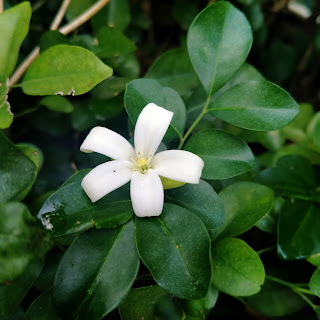
Orange jessamine, also known as Murraya paniculata, is a species of evergreen shrub or small tree that belongs to the Rutaceae family. It is native to South Asia and Southeast Asia, including countries like India, China, Malaysia, and Indonesia. This plant is popular in landscaping and gardening due to its attractive appearance and fragrant flowers.

Key characteristics of the orange jessamine include:
Leaves: The leaves are dark green, glossy, and pinnate, meaning they consist of multiple leaflets arranged in a feather-like pattern.
Flowers: The fragrant flowers are small, white, and star-shaped, similar in appearance to those of jasmine. They have a sweet, pleasant scent that attracts pollinators like bees and butterflies.
Fruits: After the flowers, orange jessamine produces small, round, orange to red fruits that turn black as they ripen. These fruits are not typically consumed by humans but may attract birds and wildlife.
Growth habit: The plant can grow up to 10-20 feet (3-6 meters) in height, forming a dense, bushy canopy.

Cultivation: Orange jessamine is relatively easy to cultivate and adapts well to a variety of soil types. It prefers well-draining soil and thrives in full sun to partial shade conditions. It is commonly used in hedges, as a specimen plant, or for screening purposes.
Toxicity: While orange jessamine is generally considered non-toxic to humans, the fruits and leaves may be toxic to pets if ingested in large quantities.
Traditional uses: In traditional medicine, various parts of the plant have been used for their medicinal properties, including treatment for pain relief, skin conditions, and respiratory issues. However, it's essential to exercise caution and consult with a medical professional before using any plant for medicinal purposes.

“Let us dance in the sun, wearing wild flowers in our hair...” ― susan polis schutz

As with any plant species, it's always best to research its specific needs and potential invasiveness in your region before introducing it to your garden or landscape. Also, be mindful of any local regulations or restrictions related to planting non-native species.

“I will be the gladdest thing under the sun! I will touch a hundred flowers and not pick one.” ― Edna St. Vincent Millay



No comments:
Post a Comment